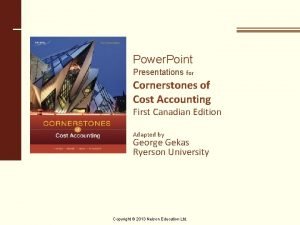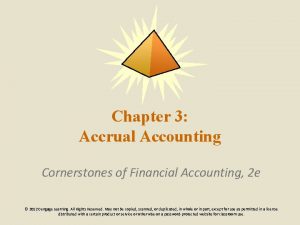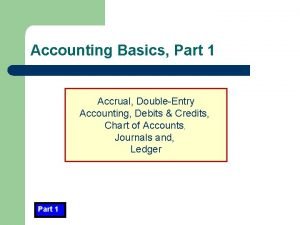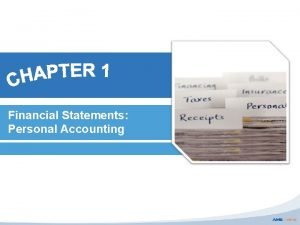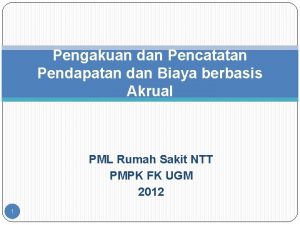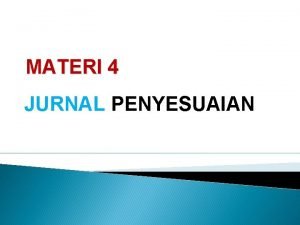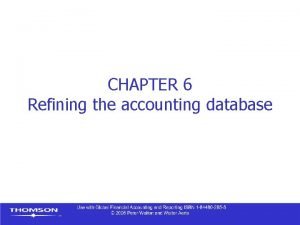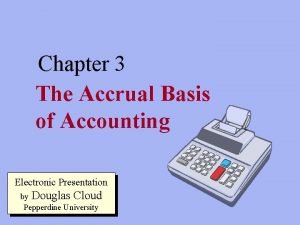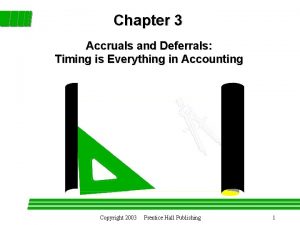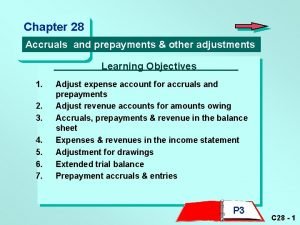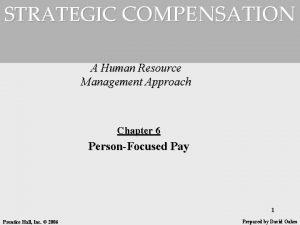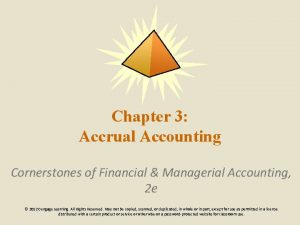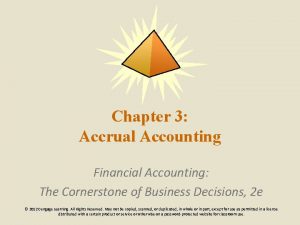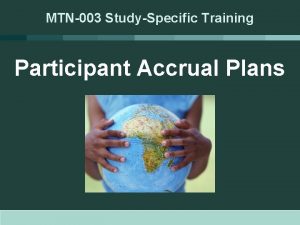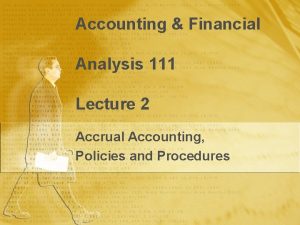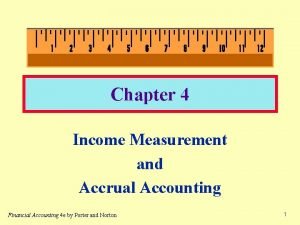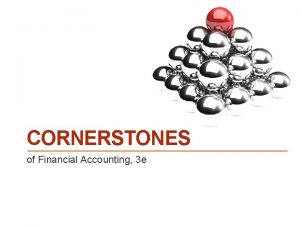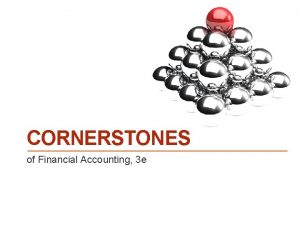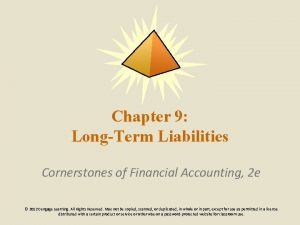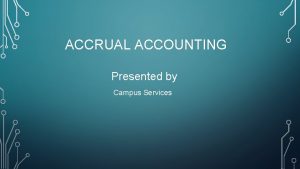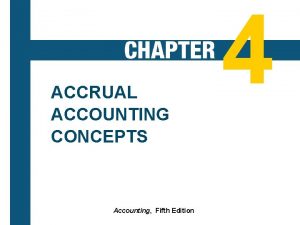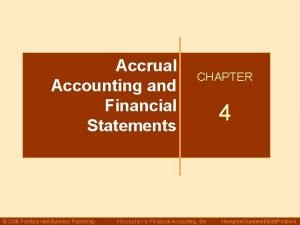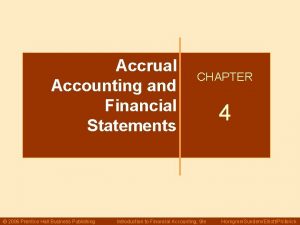Chapter 3 Accrual Accounting Cornerstones of Financial Accounting




















- Slides: 20

Chapter 3: Accrual Accounting Cornerstones of Financial Accounting, 2 e © 2012 Cengage Learning. All Rights Reserved. May not be copied, scanned, or duplicated, in whole or in part, except for use as permitted in a license distributed with a certain product or service or otherwise on a password-protected website for classroom use.

Accrual versus Cash Basis 1 of Accounting ► Under cash-basis accounting, revenue is recorded when cash is received, regardless of when it is actually earned. ► Accrual-basis accounting (also called accrual accounting) is an alternative to cash-basis accounting that is required by generally accepted accounting principles. ► Under accrual accounting, transactions are recorded when they occur. ► Accrual accounting is superior to cash-basis because it links income measurement to selling, the principle activity of the company. © 2012 Cengage Learning. All Rights Reserved. May not be copied, scanned, or duplicated, in whole or in part, except for use as permitted in a license distributed with a certain product or service or otherwise on a password-protected website for classroom use.

2 Key Elements of Accrual Accounting © 2012 Cengage Learning. All Rights Reserved. May not be copied, scanned, or duplicated, in whole or in part, except for use as permitted in a license distributed with a certain product or service or otherwise on a password-protected website for classroom use.

3 Accrual Accounting and Adjusting Entries ►Adjusting entries are journal entries made at the end of an accounting period to record the completed portion of partially completed transactions. ►Adjusting entries are necessary to apply the revenue recognition and matching principles and ensure that a company’s financial statements include the proper amount for revenues, expenses, assets, liabilities, and stockholders’ equity. © 2012 Cengage Learning. All Rights Reserved. May not be copied, scanned, or duplicated, in whole or in part, except for use as permitted in a license distributed with a certain product or service or otherwise on a password-protected website for classroom use.

4 Step 5: Adjusting the Accounts ►Adjustments are often necessary because timing differences exist between when a revenue or expense is recognized and cash is received or paid. ►The purpose of all adjustments is to make sure revenues and expenses get recorded in the proper time period. ►All adjusting entries will affect at least one income statement account and one balance sheet account. ►Note that cash is never affected by adjustments. © 2012 Cengage Learning. All Rights Reserved. May not be copied, scanned, or duplicated, in whole or in part, except for use as permitted in a license distributed with a certain product or service or otherwise on a password-protected website for classroom use.

4 Three Step-Process for Making Adjusting Entries ►A three-step procedure can be followed for making adjusting journal entries. ►Step 1: Identify pairs of income statement and balance sheet accounts that require adjustment. ►Step 2: Calculate the amount of the adjustment based on the amount of revenue that was earned or the amount of expense that was incurred during the accounting period. ►Step 3: Record the adjusting journal entry. © 2012 Cengage Learning. All Rights Reserved. May not be copied, scanned, or duplicated, in whole or in part, except for use as permitted in a license distributed with a certain product or service or otherwise on a password-protected website for classroom use.

4 Types of Adjusting Entries © 2012 Cengage Learning. All Rights Reserved. May not be copied, scanned, or duplicated, in whole or in part, except for use as permitted in a license distributed with a certain product or service or otherwise on a password-protected website for classroom use.

4 Accrued Revenues ► Companies often engage in revenue-producing activities but are not paid until after the activities are complete. ► If a company has earned revenue but not received the cash, these transactions are called accrued revenues. An example of an accrued revenue is interest earned, but not yet received, on a loan. ► As the diagram below indicates, the revenue is earned before cash is received. © 2012 Cengage Learning. All Rights Reserved. May not be copied, scanned, or duplicated, in whole or in part, except for use as permitted in a license distributed with a certain product or service or otherwise on a password-protected website for classroom use.

4 Deferred (Unearned) Revenues ► Transactions for which a company has received cash but has not yet earned the revenue are called deferred (or unearned) revenues. ► Examples of deferred revenues include rent received in advance, magazine or newspaper subscriptions received in advance, and tickets (e. g. , for airlines, sporting events, concerts) sold in advance. ► In all of these situations, the receipt of cash creates a liability for the company to deliver goods or perform services in the future. © 2012 Cengage Learning. All Rights Reserved. May not be copied, scanned, or duplicated, in whole or in part, except for use as permitted in a license distributed with a certain product or service or otherwise on a password-protected website for classroom use.

4 Deferred (Unearned) Revenues (continued) ► The unearned revenue account delays, or defers, the recognition of revenue by recording the revenue as a liability until it is earned. © 2012 Cengage Learning. All Rights Reserved. May not be copied, scanned, or duplicated, in whole or in part, except for use as permitted in a license distributed with a certain product or service or otherwise on a password-protected website for classroom use.

4 Deferred (Prepaid) Expenses ► Companies often acquire goods and services before they are used. ► These prepayments are recorded as assets called deferred (or prepaid) expenses. ► As this diagram shows, the deferral of the expense is necessary because the initial cash payment did not result in an expense, but an asset that results in future benefits. © 2012 Cengage Learning. All Rights Reserved. May not be copied, scanned, or duplicated, in whole or in part, except for use as permitted in a license distributed with a certain product or service or otherwise on a password-protected website for classroom use.

4 Depreciation ►Because property, plant, and equipment (long-lived assets) help to produce revenue over a number of years (instead of just one period), the matching principle requires companies to systematically assign or allocate the cost of these assets as expense to each period in which they are used. This process is called depreciation. ►The depreciation process requires an adjustment to recognize the expense incurred during the period and reduce the long-lived asset. ►The unused portion of a long-lived asset is reported on the balance sheet. © 2012 Cengage Learning. All Rights Reserved. May not be copied, scanned, or duplicated, in whole or in part, except for use as permitted in a license distributed with a certain product or service or otherwise on a password-protected website for classroom use.

4 Contra Accounts ►Accountants normally use a contra account to reduce the amount of a long-lived asset. ►Contra accounts are accounts that have a balance that is opposite of the balance in the related account e. g. , Accumulated Depreciation account. ►Therefore, while an asset has a normal debit balance, a contra asset account has a normal credit balance. ►Contra asset account balance is deducted from the balance of the related asset account in the financial statement (balance sheet), and the resulting difference is known as the book value of the asset. © 2012 Cengage Learning. All Rights Reserved. May not be copied, scanned, or duplicated, in whole or in part, except for use as permitted in a license distributed with a certain product or service or otherwise on a password-protected website for classroom use.

Summary of Financial Statement 4 Effects of Adjusting Entries © 2012 Cengage Learning. All Rights Reserved. May not be copied, scanned, or duplicated, in whole or in part, except for use as permitted in a license distributed with a certain product or service or otherwise on a password-protected website for classroom use.

5 Step 6: Preparing the Financial Statements ►After a company has journalized and posted all of the adjusting entries, it updates the trial balance to reflect the adjustments that have been made. ►This trial balance is called an adjusted trial balance. ►Similar to the trial balance, the adjusted trial balance lists all of the active accounts and proves the equality of debits and credits. © 2012 Cengage Learning. All Rights Reserved. May not be copied, scanned, or duplicated, in whole or in part, except for use as permitted in a license distributed with a certain product or service or otherwise on a password-protected website for classroom use.

5 Adjusted Trial Balance © 2012 Cengage Learning. All Rights Reserved. May not be copied, scanned, or duplicated, in whole or in part, except for use as permitted in a license distributed with a certain product or service or otherwise on a password-protected website for classroom use.

5 Relationship Among the Financial Statements © 2012 Cengage Learning. All Rights Reserved. May not be copied, scanned, or duplicated, in whole or in part, except for use as permitted in a license distributed with a certain product or service or otherwise on a password-protected website for classroom use.

6 Step 7: Closing the Accounts ► The balance sheet accounts- assets, liabilities, and stockholders’ equity- are permanent accounts in that their balances are carried forward from the current accounting period to future accounting periods. ► Revenues, expenses, and dividends are used to collect the activities of only one period, so they are considered temporary accounts. ► The final step of the accounting cycle, closing the accounts, is done to: ►Transfer the effects of revenues, expenses, and dividends (the temporary accounts) to the permanent stockholders’ equity account, Retained Earnings. ►Clear the revenue, expenses, and dividends (reduce their balances to zero) so they are ready to accumulate the business activities of the next accounting period. © 2012 Cengage Learning. All Rights Reserved. May not be copied, scanned, or duplicated, in whole or in part, except for use as permitted in a license distributed with a certain product or service or otherwise on a password-protected website for classroom use.

7 Summary of the Accounting Cycle © 2012 Cengage Learning. All Rights Reserved. May not be copied, scanned, or duplicated, in whole or in part, except for use as permitted in a license distributed with a certain product or service or otherwise on a password-protected website for classroom use.

Appendix: Using a Worksheet 8 to Prepare Financial Statements ► Accountants often use an informal schedule called a worksheet to assist them in organizing and preparing the information necessary to perform the end-of-period steps in the accounting cycle—namely the preparation of adjusting entries, financial statements, and closing entries. ► The worksheet is not a financial statement but simply an organizational tool that summarizes the information generated by the accounting system and enables the accountant to check the information for completeness and consistency. ► While worksheets can be completed manually, most worksheets today are created in computer spreadsheets. © 2012 Cengage Learning. All Rights Reserved. May not be copied, scanned, or duplicated, in whole or in part, except for use as permitted in a license distributed with a certain product or service or otherwise on a password-protected website for classroom use.
 Cornerstones of cost accounting
Cornerstones of cost accounting Accrual accounting concept
Accrual accounting concept Chapter 4 accrual accounting concepts
Chapter 4 accrual accounting concepts Identify the cornerstones of the wellness movement
Identify the cornerstones of the wellness movement Accrual accounting principles
Accrual accounting principles Accrual accounting basics
Accrual accounting basics Personal income statement
Personal income statement Akrual
Akrual Financial accounting chapter 1
Financial accounting chapter 1 Responsibility center ppt
Responsibility center ppt Can i use protected pto to leave early
Can i use protected pto to leave early Accrual basis
Accrual basis Unt vacation accrual
Unt vacation accrual Provision vs accrual
Provision vs accrual Accrual and deferral
Accrual and deferral Accruals and deferrals
Accruals and deferrals Prepayment and accrual
Prepayment and accrual Vendor rebates
Vendor rebates As 29 accounting standard
As 29 accounting standard Job point accrual model
Job point accrual model Accrual concept
Accrual concept
